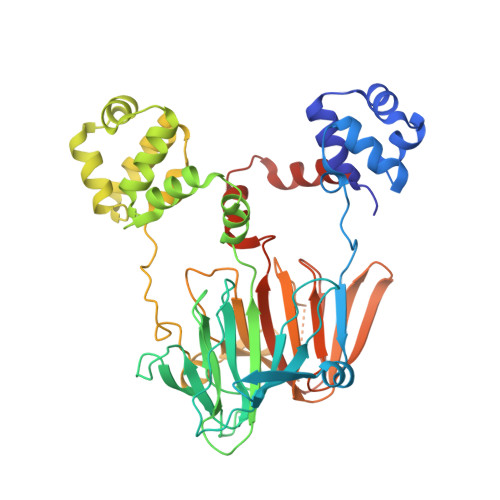Mechanism and substrate recognition of 2-hydroxyethylphosphonate dioxygenase.
Peck, S.C., Cooke, H.A., Cicchillo, R.M., Malova, P., Hammerschmidt, F., Nair, S.K., van der Donk, W.A.(2011) Biochemistry 50: 6598-6605
- PubMed: 21711001
- DOI: https://doi.org/10.1021/bi200804r
- Primary Citation of Related Structures:
3RZZ - PubMed Abstract:
HEPD belongs to the superfamily of 2-His-1-carboxylate non-heme iron-dependent dioxygenases. It converts 2-hydroxyethylphosphonate (2-HEP) to hydroxymethylphosphonate (HMP) and formate. Previously postulated mechanisms for the reaction catalyzed by HEPD cannot explain its conversion of 1-HEP to acetylphosphate. Alternative mechanisms that involve either phosphite or methylphosphonate as intermediates, which potentially explain all experimental studies including isotope labeling experiments and use of substrate analogues, were investigated. The results of these studies reveal that these alternative mechanisms are not correct. Site-directed mutagenesis studies of Lys16, Arg90, and Tyr98 support roles of these residues in binding of 2-HEP. Mutation of Lys16 to Ala resulted in an inactive enzyme, whereas mutation of Arg90 to Ala or Tyr98 to Phe greatly decreased k(cat)/K(m,2-HEP). Furthermore, the latter mutants could not be saturated in O(2). These results suggest that proper binding of 2-HEP is important for O(2) activation and that the enzyme uses a compulsory binding order with 2-HEP binding before O(2). The Y98F mutant produces methylphosphonate as a minor side product providing indirect support for the proposal that the last step during catalysis involves a ferric hydroxide reacting with a methylphosphonate radical.
Organizational Affiliation:
Department of Chemistry and Howard Hughes Medical Institute and ‡Institute for Genomic Biology, University of Illinois , 1206 West Gregory Drive, Urbana, Illinois 61801, United States.















